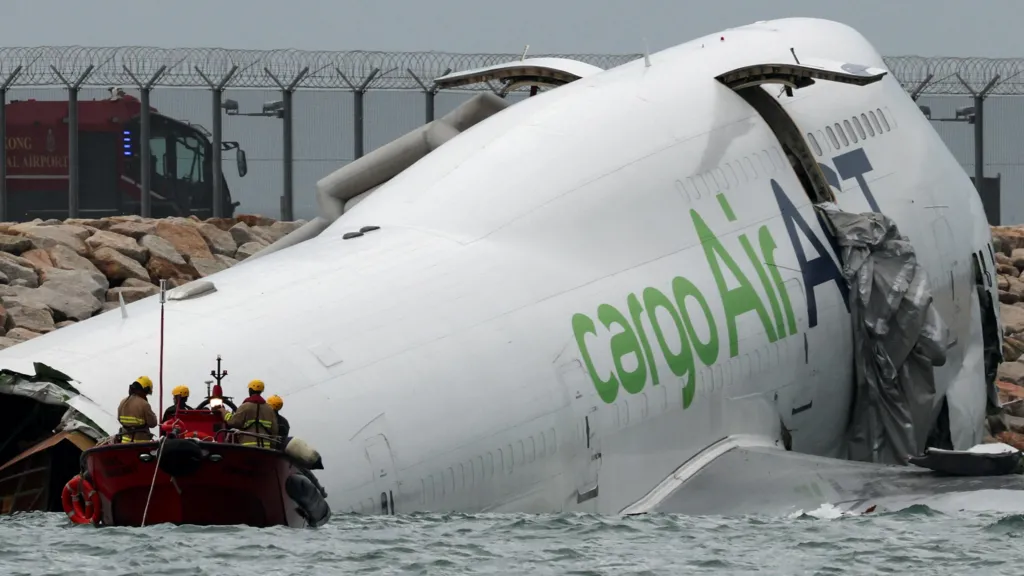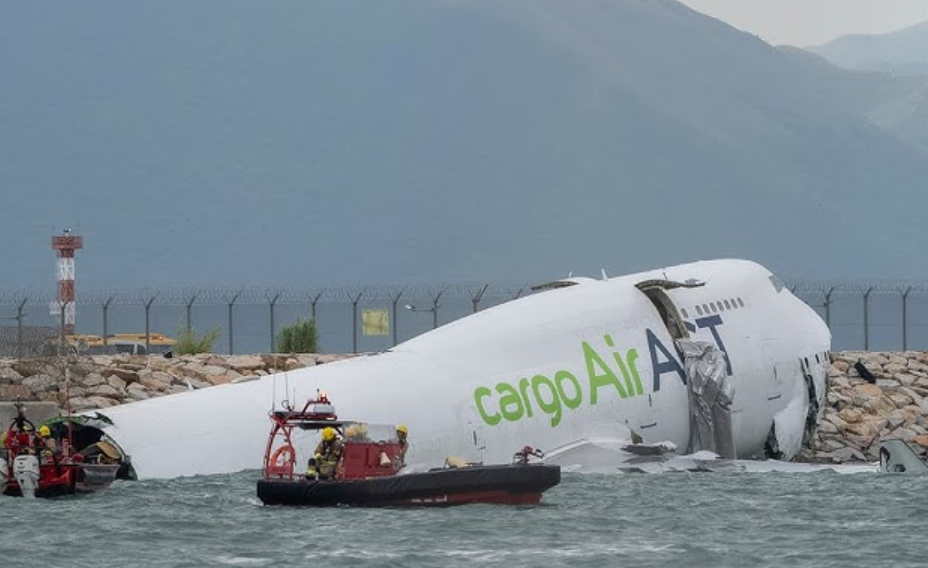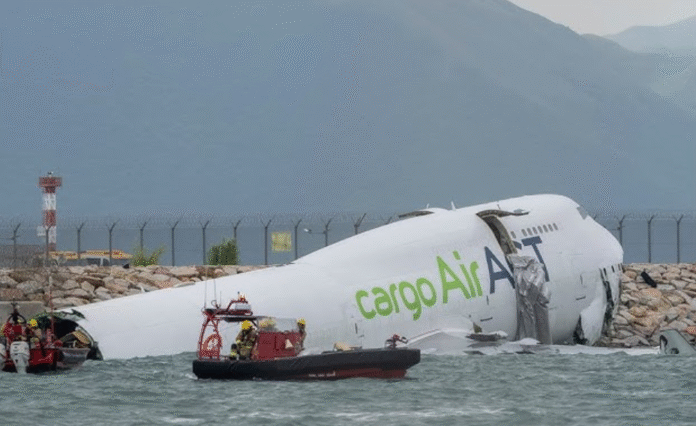A shocking cargo plane crash Hong Kong early Monday morning has left two ground staff dead after an Emirates aircraft skidded off the runway at Hong Kong International Airport and plunged into the sea. The accident marks one of the deadliest aviation incidents in the city in recent years, raising serious questions about runway safety and flight procedures.
The Emirates flight EK9788, arriving from Dubai at around 03:50 local time (19:50 GMT), veered off course during landing, colliding with an airport patrol vehicle before breaking through a fence and landing in the water. While the four crew members aboard the Boeing 747 cargo jet miraculously survived, the two staff inside the patrol car tragically lost their lives.

Investigation Begins After Cargo Plane Crash Hong Kong
Authorities have launched a full-scale investigation into the cargo plane crash Hong Kong, as investigators work to determine how the aircraft went off its designated path. Airport officials confirmed that all standard landing instructions were properly communicated to the Emirates flight, and that signage and runway markers were in place.
According to airport operations executive director Steven Yiu, the patrol car was traveling along a road outside the runway fencing, not on the tarmac, when the plane unexpectedly swerved toward the sea. “Normally, the plane is not supposed to turn in that direction,” Yiu explained during a press conference, stressing that the vehicle was in a safe zone.
Yiu added that the aircraft did not issue a distress signal before impact. The plane broke through the runway fence, hitting the patrol car and pushing it into the ocean. Divers later recovered the bodies of the two ground staff, aged 30 and 41, who had worked at the airport for several years.
Officials Express Sorrow and Pledge Full Accountability
Hong Kong’s transport bureau expressed its deep condolences to the victims’ families, calling the tragedy “heartbreaking.” Authorities vowed to conduct a thorough investigation to prevent such a disaster from ever happening again.
An Emirates spokesperson confirmed that flight EK9788 “sustained damage upon landing in Hong Kong,” but clarified that there was no cargo onboard at the time of the crash. The airline also revealed that the Boeing 747-481 aircraft was wet-leased from Turkish carrier ACT Airlines, meaning Emirates had rented the plane along with its crew and insurance from the Turkish operator.
Fire and rescue teams responded within minutes of the crash. The four crew members managed to open the emergency doors and were quickly rescued from the half-submerged wreckage. Photos from the scene show the aircraft split into two large sections, with one part submerged underwater and a large crack running along the fuselage.
Cargo Plane Crash Hong Kong: What Happened During Landing
The cargo plane crash Hong Kong has prompted experts to question how an experienced flight crew could lose control of such a large aircraft during routine landing operations. Initial reports suggest that weather conditions were stable and visibility was good.
According to aviation analyst Thomas Li, the lack of a distress signal suggests that the pilots may have been caught off guard by a sudden mechanical failure or landing gear malfunction. “The speed and trajectory of the aircraft as it approached the runway will be key to understanding what went wrong,” Li said.
The Hong Kong Air Accident Investigation Authority (AAIA) has already deployed divers to retrieve the plane’s black boxes, the flight data recorder and cockpit voice recorder, from the sea. These devices are expected to reveal crucial details about the aircraft’s speed, altitude, and crew communications in the moments before the crash.
Airport Disruptions and Ongoing Safety Concerns
Following the cargo plane crash Hong Kong, one of the airport’s main runways has been closed for the rest of the day while investigators comb through the wreckage. However, the airport’s other two runways remain operational to minimize flight disruptions.
At least 11 scheduled cargo flights were canceled on Monday, and some passenger flights faced delays as crews cleared debris from the crash site.
This is only the second deadly aviation incident at Chek Lap Kok Airport since it opened in 1998. The first occurred in August 1999, when a China Airlines passenger jet crash-landed during a typhoon, killing three people.
Aviation Experts Call for Enhanced Ground Coordination
The cargo plane crash Hong Kong has reignited debate over airport safety protocols, especially regarding coordination between aircraft and ground vehicles. Experts are calling for stronger barriers and advanced detection systems that could alert both pilots and ground staff to potential hazards.
Aviation safety specialist Derek Wong stated that “human error, combined with unexpected aircraft deviation, can create tragic consequences.” He added that modern radar and AI-powered monitoring systems should be implemented to prevent collisions between planes and service vehicles.
Environmental conditions, crew fatigue, and maintenance records of the aircraft will also be scrutinized in the coming weeks as part of the AAIA’s investigation.

Global Reactions and Support for Victims
Airlines and aviation authorities worldwide have expressed condolences to the victims’ families and offered technical support to Hong Kong’s investigation team. Emirates has pledged full cooperation and assistance to local authorities while also launching its internal review.
Several international aviation safety organizations, including the International Air Transport Association (IATA), have praised the swift emergency response that helped save the crew members’ lives.
As Hong Kong mourns the loss of two of its dedicated airport workers, the aviation community awaits answers, hoping this tragic cargo plane crash Hong Kong will serve as a reminder of the need for constant vigilance in air safety operations.

